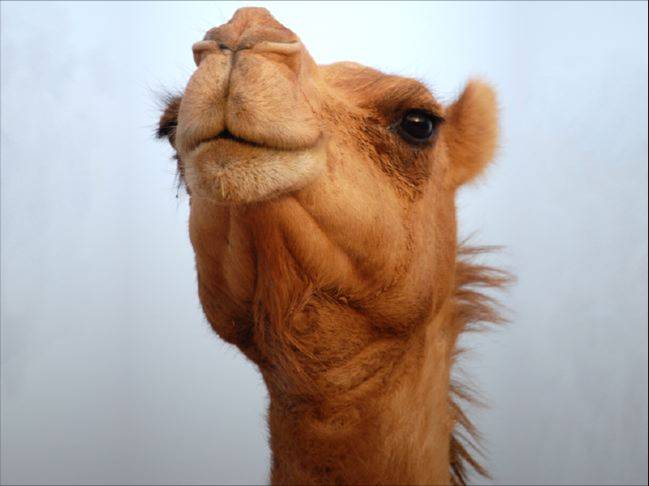Camels have lived in some of the most desolate corners of our planet, and not only do they live,…. |
Camels have lived in some of the most desolate corners of our planet, and not only do they live, they thrive. Most large animals are unable to survive in these kinds of desolate places. This is because of their large requirement for resources such as food and water. Camels are able to use this to their advantage as a survival strategy.
Allah almighty had supported this animal with some characteristics to enable it to live in desert in unbearable circumstances. The question is why the nature or coincidence did support that animal with these characteristics and didn't support the others!!!?
Camels can travel long distances which allow them to take advantage of the maximum number of resources. They can withstand a massive amount of dehydration which allows them to survive not only between watering holes, but sometimes between seasons. For food, camels are omnivorous. They can eat almost anything be it vegetation, meat, or bone, -- salty or sweet, a camels stomach knows no limits.
Look at this beautiful creation, when we see that we have to remember Allah's saying: (Say: "Have ye seen (these) 'Partners' of yours whom ye call upon besides God? Show me what it is they have created in the (wide) earth. Or have they a share in the heavens?)(Sûrat Fatir- verse40)
General Characteristics of the camel
The camel's body Length is 300 cm (10ft) and its Shoulder Height is 180-210 cm (6-7 ft). The Tail Length of the camel is 50 cm (20in) and its weight is from 600 to1000 kg (1320-2200 lb).
The smooth coat is beige to light brown in wild-type individuals, with the undersides slightly lighter. The legs are long and slender, with callousness on the 'knees' where they touch the ground when the animal is lying down. Though often called the one-humped camel, the dromedary has two humps used for energy storage in the form of fat. The under-developed anterior hump sits over the shoulders and the large rear hump is found in the centre of the back. The upper lip is deeply split, and the nostrils can be closed. There are long eyelashes, which help to keep sand out of the eyes. The two broad toes on the feet are able to spread widely as an adaptation to walking on sand.
Ecology and Behavior
The ability of the camel to survive in desert conditions without water for long periods of time is rivaled by none. The many physiological adaptations the dromedary has even earned it the title "ship of the desert". Dromedaries can glean much of their needed water from desert vegetation, and can survive after losing over 40 percent of their body weight in water.
When water is available (fresh or salty), camels drink well - up to 57 liters at a time. Camels also have a flexible 'thermostat', and will not start sweating until their body temperature reaches 42oC / 107.5oF. Nor do heating mechanisms kick in during the cooler nights until the internal temperature reaches 34oC / 92oF. Besides saving energy, this physiological adaptation allows the camel to "store" coolness in preparation for the next day. On hot days, dromedaries will rest together in closely packed groups, with reduces the heat reflecting off of the ground considerably.

The mouth is very sturdy, able to chew thorny desert plants. Long eyelashes and ear hairs, together with sealable nostrils, form a barrier against sand. Their gait and their widened feet help them move without sinking into the sand
Also to save water the kidneys and intestine of a camel are very efficient at retaining water. Urine comes out as thick syrup, and their feces are so dry that they can fuel fires. Camels do not store water in their humps as is commonly believed. The humps are actually a reservoir of fatty tissue. Concentrating body fat in their humps minimizes heat-trapping insulation throughout the rest of their body, which may be an adaptation to living in hot climates. When this tissue is metabolized, it acts as a source of energy, and yields more than 1 g of water for each 1 g of fat converted through reaction with oxygen from air.

This car is a human made… But who created this magnificent? Creation, coincidence or blind nature?
Allah says: (Do they not look at the Camels, how they are made?* and at the Sky, how it is raised high?* and at the Mountains, how they are fixed firm?*and at the Earth, how it is spread out?*Therefore do thou give admonition, for thou art one to admonish) (Sûrat Al-Ghasyha verse 17-21).
--------------------
By: Abduldaem Al-Kaheel
References:
1. http://fohn.net/camel-pictures-facts/
2. http://www.ultimateungulate.com/Artiodactyla/Camelus_dromedarius.html



ليست هناك تعليقات:
إرسال تعليق